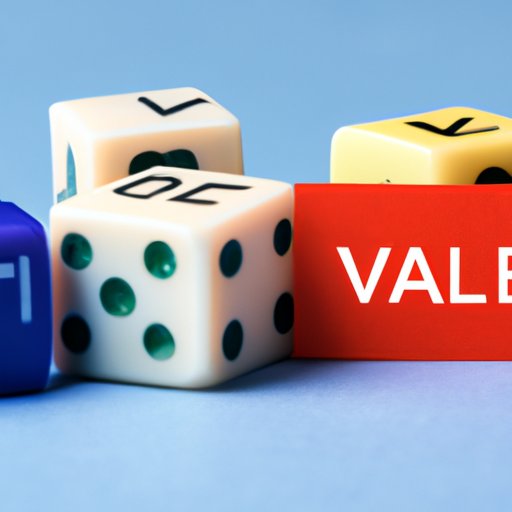Introduction
Expected value is a statistical concept used to measure the potential gains or losses resulting from a decision in situations where the outcome is uncertain. It is a critical tool in decision making, providing insights into the probabilities of different outcomes and helping us make informed choices.
Expected value is applicable in a range of fields, including business, finance, gambling, and personal decision making. In this article, we will explore what expected value is, why it matters in decision making, and how to calculate it.

Why Expected Value Matters in Decision Making: A Comprehensive Guide to Mastering It
The concept of expected value involves calculating the total value of all possible outcomes weighted by the probability of each occurring. It applies to scenarios where there is uncertainty about the outcome, and the decision maker needs to weigh the potential risks and benefits of different choices.
Expected value can be positive, negative, or zero, depending on the potential results. A positive expected value indicates a favorable outcome, while a negative expected value indicates an unfavorable outcome. A zero expected value implies that the potential gains and losses balance out, meaning the decision isn’t likely to have a significant impact on the outcome.
Expected value is closely related to probability, as it is calculated by multiplying the probability of each outcome by its respective value and then summing the resulting values. The higher the probability of a specific outcome, the greater its weighting in the expected value calculation.
There are many examples of expected value calculation in different scenarios. For example, in insurance, companies assess the likelihood of an event occurring (e.g., a car accident) and calculate the expected value of the potential payout for policyholders. In finance, expected value is used to determine the potential returns of investments.
Calculating Expected Value: Simple Steps to Making Better Choices
The formula for calculating expected value is as follows:
Expected value = (outcome 1 x probability 1) + (outcome 2 x probability 2) + … + (outcome n x probability n)
To calculate expected value, you need to know the values and probabilities of each possible outcome. Once you have this information, follow these steps:
- Assign each outcome a value
- Assign each outcome a probability
- Multiply each outcome value by its probability
- Sum the resulting products
Let’s say you’re considering investing in a startup. You estimate that there is a 60% chance of gaining $10,000 and a 40% chance of losing $5,000. To calculate the expected value of this investment, you would follow these steps:
- The value of gaining $10,000 is +$10,000, and the value of losing $5,000 is -$5,000
- The probability of gaining $10,000 is 60%, and the probability of losing $5,000 is 40%
- Multiply the value of each outcome by its probability: (+$10,000 x 60%) + (-$5,000 x 40%) = +$1,000
- The expected value of this investment is $1,000, which is positive and suggests that this investment is a good decision.
By calculating the expected value, you can make a more informed decision by considering the potential risks and rewards of each choice.
The Importance of Expected Value in Gambling and Investing
Expected value is crucial in both gambling and investing, where decision making relies heavily on measuring risk versus reward.
In gambling, expected value is the average amount a player can expect to win or lose per bet, calculated by multiplying the amount at risk by the probability of winning or losing. For example, in a casino game of roulette with a 50-50 chance of winning $1, a player’s expected value is zero because their potential winnings and losses are equal.
In investing, expected value is used to determine the potential profitability of an investment by considering the probability of different outcomes. For example, a high-risk investment might have the potential for a significant return, but with a low probability of success, resulting in a low expected value.
Expected value is also vital in risk management, where decision making requires evaluating the potential risks and benefits of different courses of action. By using expected value, investors can balance their portfolios to reduce overall risk and achieve more predictable outcomes.
Playing the Odds: Utilizing Expected Value to Improve Your Chances at Winning
Understanding probability is crucial in assessing expected value, as it is used to determine the weighting of each outcome. In gambling, expected value can be used to make better decisions about which games to play and which bets to place.
To calculate the odds of winning and expected value in gambling, follow these steps:
- Determine the probability of each outcome
- Multiply each outcome by its probability
- Calculate the sum of the products to find the expected value
Let’s say you’re considering betting on a football game. The odds of the home team winning are 2/1, and the odds of the away team winning are 3/1. The probability of each outcome can be calculated by dividing the total odds by the individual odds. In this case:
- Probability of the home team winning: 2/(2+1) = 0.67
- Probability of the away team winning: 3/(3+1) = 0.75
To calculate the expected value, multiply each outcome by its probability and sum the products:
(2 x 0.67) + (-1 x 0.33) = 1.34 – 0.33 = 1.01
The expected value of this bet is positive, indicating that it is a good decision to place this wager.
Expected Value for Dummies: Understanding the Concept and How to Apply It
Expected value can be challenging to understand, especially for beginners. However, by breaking it down into simpler terms, it’s possible to grasp the concept.
Expected value is a statistical concept that involves calculating the potential results of a decision based on the different outcomes and their probabilities. In essence, it is a way of measuring the average outcome of a decision over time.
In real-world situations, expected value can be used to make decisions in various fields, including finance, insurance, and personal decision making. By considering the potential risks and benefits of different choices, decision makers can weigh the pros and cons and make more informed decisions.
Maximizing Profitability: How Expected Value Can Help You Make Better Business Decisions
Expected value is essential in business decision making, allowing businesses to assess the risks and benefits of different choices and make informed decisions.
For example, when considering a new project or investment opportunity, a business can calculate the expected value based on the potential costs, revenues, and risks. By comparing the expected value of different options, they can make the best decision based on potential outcomes.
Real-world examples of companies that use expected value in decision making include Goldman Sachs, which uses the metric to assess investment risks, and General Electric, which uses expected value to evaluate potential projects.
By incorporating expected value into business strategy, businesses can make informed decisions and maximize profitability.
From Statistics to Strategy: Using Expected Value to Analyze Outcomes and Minimize Risk
Expected value is a critical tool in statistical analysis, allowing businesses to evaluate potential outcomes and minimize risk.
For example, in strategic planning, businesses can use expected value to determine the potential outcomes of different scenarios and make decisions that will minimize negative outcomes. When evaluating potential risks, expected value can be used to weigh the probability of each risk and make decisions accordingly.
Expected value can also be used in risk management to assess the likelihood of specific risks and make recommendations to mitigate them. By considering the potential outcomes of different risks, businesses can make decisions that minimize the probability of negative outcomes.
Conclusion
Expected value is an essential concept in decision making, helping individuals and businesses weigh the potential risks and benefits of different choices. By using statistics and probability to measure the potential outcomes of a decision, decision makers can make informed choices and minimize risk.
From gambling and investing to business strategy and personal decisions, expected value is a versatile tool that can be applied in a range of situations. Understanding expected value is critical to making informed and rational decisions, and it is an essential skill for anyone looking to improve their decision-making processes.
